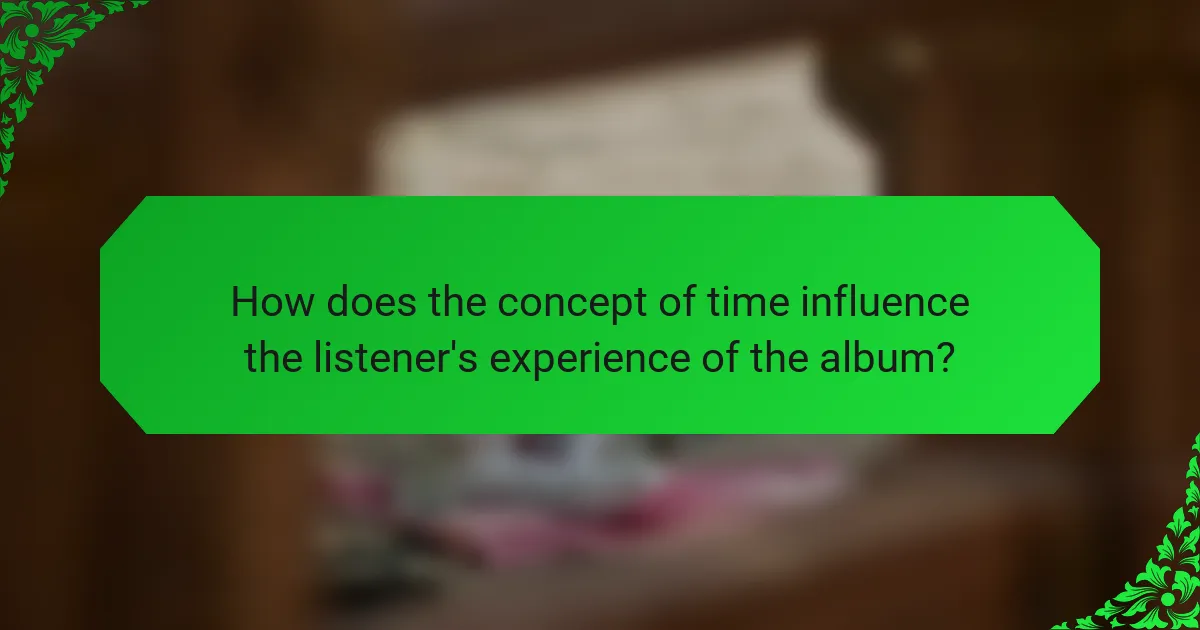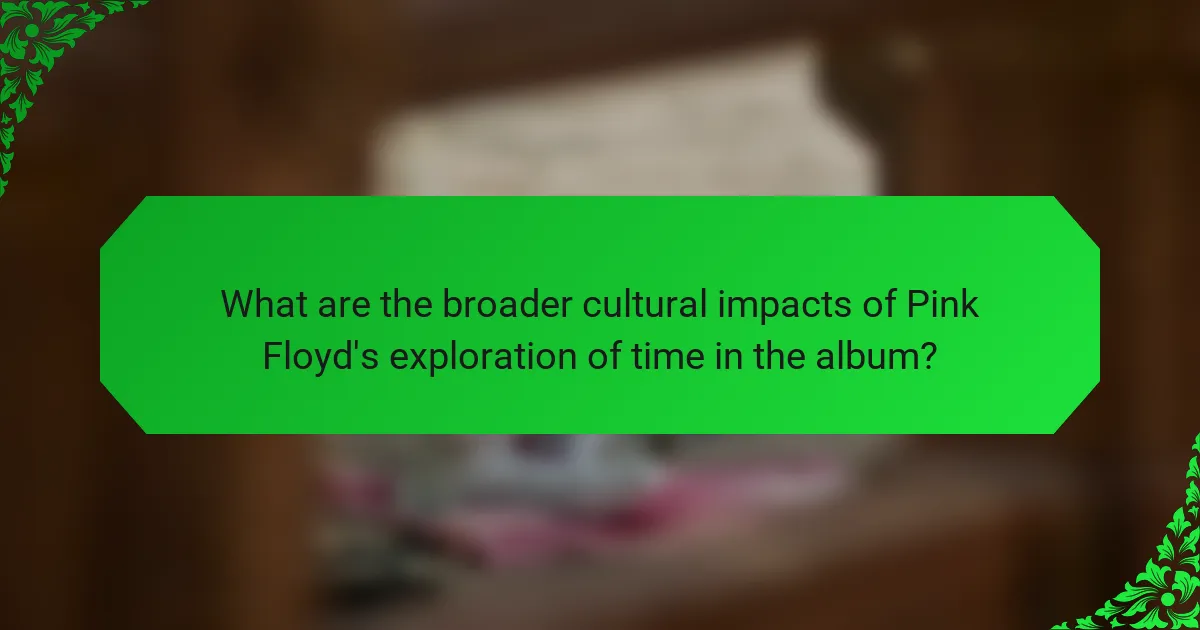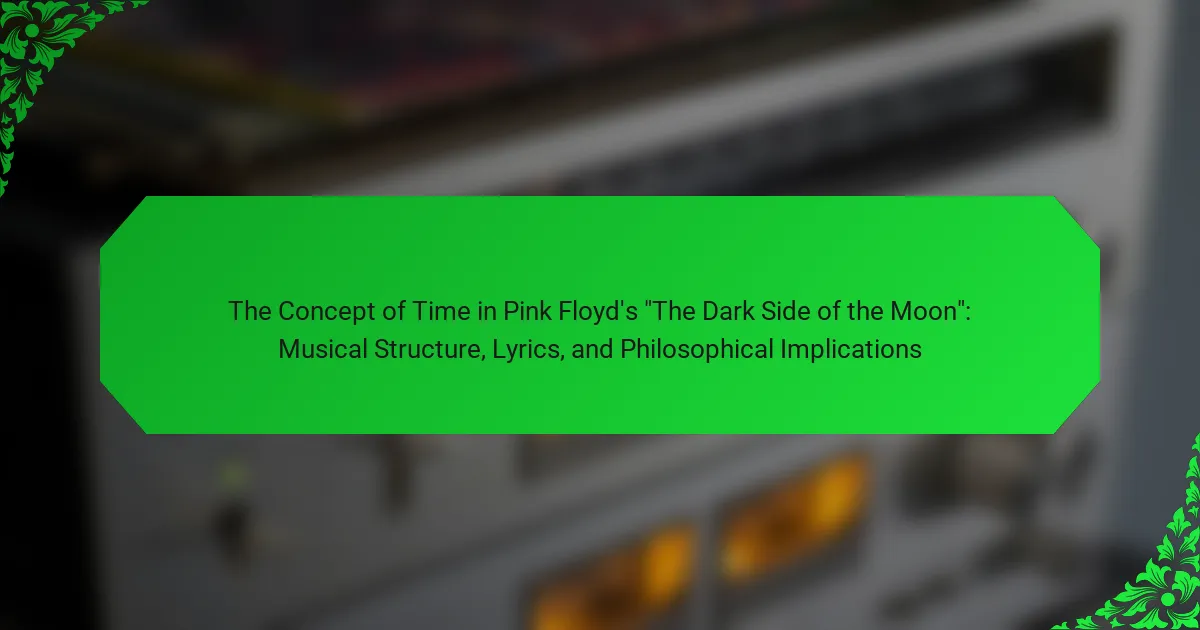The main entity discussed in this article is Pink Floyd’s album “The Dark Side of the Moon,” with a specific focus on the concept of time. The article examines how time is depicted as a relentless force that influences human existence and mental health within the album’s musical structure and lyrics. Key themes include the anxiety surrounding aging, missed opportunities, and the urgency of life, particularly highlighted in the track “Time,” which uses sound effects to reinforce its message. The seamless transitions between songs contribute to a cohesive listening experience that mirrors the passage of time. Additionally, the article explores the cultural impact of the album, emphasizing its legacy in discussions about music, existential philosophy, and mindfulness in relation to time.

What is the concept of time as explored in Pink Floyd’s “The Dark Side of the Moon”?
The concept of time in Pink Floyd’s “The Dark Side of the Moon” is depicted as a relentless and often oppressive force. The album explores how time affects human existence and mental health. The lyrics express feelings of anxiety and the inevitability of aging. The song “Time” features clock sounds to emphasize its passage. It reflects on missed opportunities and the fleeting nature of life. The musical structure complements these themes with gradual builds and transitions. Overall, the work presents time as an inescapable reality that shapes human experience.
How does the musical structure of the album reflect the theme of time?
The musical structure of Pink Floyd’s “The Dark Side of the Moon” reflects the theme of time through its seamless transitions and recurring motifs. The album features continuous flow between tracks, creating a sense of an unbroken timeline. This structure mirrors the relentless passage of time in life. The use of time signatures and tempo changes further emphasizes the fluidity of time. For instance, the song “Time” incorporates ticking clocks, symbolizing the urgency of time passing. Additionally, thematic elements in the lyrics connect personal experiences with the broader concept of time. The interplay of musical themes reinforces the cyclical nature of existence, illustrating how time influences human experiences.
What specific musical techniques are used to convey the passage of time?
Musical techniques used to convey the passage of time include tempo changes, rhythmic variations, and dynamic shifts. Tempo changes create a sense of acceleration or deceleration. Rhythmic variations can evoke feelings of urgency or stagnation. Dynamic shifts, such as crescendos and diminuendos, enhance emotional responses related to time. Additionally, the use of repetitive motifs can symbolize the cyclical nature of time. In “The Dark Side of the Moon,” these techniques are employed effectively to reflect themes of time and existence. The album’s structure, with its seamless transitions, further emphasizes the continuous flow of time.
How do the transitions between tracks enhance the concept of time?
Transitions between tracks in Pink Floyd’s “The Dark Side of the Moon” enhance the concept of time by creating a seamless flow that mimics the passage of life. Each transition serves to connect themes and musical motifs, reinforcing the idea of continuity. For example, the transition from “Time” to “Breathe (Reprise)” highlights the cyclical nature of existence. This fluidity suggests that moments are interconnected rather than isolated. Additionally, the use of sound effects, such as clocks and heartbeat sounds, emphasizes the relentless progression of time. These techniques illustrate how time is experienced, not just measured. The album’s structure invites listeners to reflect on their own temporal experiences. Thus, the transitions effectively deepen the philosophical exploration of time within the album.
What role do the lyrics play in expressing the concept of time?
The lyrics in Pink Floyd’s “The Dark Side of the Moon” significantly express the concept of time. They explore themes of aging, mortality, and the passage of time. Phrases like “Time is ticking away” illustrate a sense of urgency and inevitability. The lyrics reflect on how time affects human experiences and emotions. They convey a feeling of loss associated with time’s relentless progression. The repetition of certain lines emphasizes the cyclical nature of time. Overall, the lyrics serve as a poignant commentary on the human condition in relation to time.
How do specific lines in the lyrics address the nature of time?
Specific lines in the lyrics of Pink Floyd’s “The Dark Side of the Moon” explore the nature of time by illustrating its fleeting and cyclical aspects. For instance, the phrase “Time is a thief” conveys the idea that time steals moments from life. This line suggests a loss of control over time and highlights its relentless passage. Additionally, the lyrics reference “wasting time,” which emphasizes the urgency to utilize time wisely. Another line mentions “hanging on in quiet desperation,” portraying the struggle against the inevitable progression of time. These expressions collectively reflect the existential contemplation of time as both a precious resource and an unstoppable force.
What metaphors related to time are present in the lyrics?
The lyrics of Pink Floyd’s “The Dark Side of the Moon” contain several metaphors related to time. One prominent metaphor is time as a relentless force, depicted through phrases that illustrate its unyielding passage. The song “Time” describes how life slips away if not actively engaged. Another metaphor is the imagery of clocks and alarms, symbolizing the urgency and pressure of time. Additionally, the concept of time as a thief is prevalent, suggesting that it steals moments from life. These metaphors collectively emphasize the fleeting nature of existence and the inevitability of aging. They reflect a philosophical contemplation on how time influences human experience.
What philosophical implications of time are presented in the album?
The album presents philosophical implications of time as a cyclical and subjective experience. It explores how time affects human perception and consciousness. The lyrics suggest that time can lead to existential anxiety and a sense of inevitability. The music structure emphasizes the continuity and flow of time through seamless transitions. This reflects the idea that past, present, and future are interconnected. The use of sound effects, like clocks ticking, reinforces the relentless passage of time. Overall, the album invites listeners to contemplate their relationship with time and its impact on life.
How does the album challenge conventional perceptions of time?
The album “The Dark Side of the Moon” challenges conventional perceptions of time through its seamless musical transitions and thematic exploration. The tracks flow into one another without traditional breaks, creating a continuous auditory experience. This structure reflects the cyclical nature of time rather than a linear progression. Lyrically, the album addresses existential themes, emphasizing the fleeting nature of life and the inevitability of time. For instance, the song “Time” features lyrics that highlight how time can slip away unnoticed. The use of sound effects, such as clocks ticking, reinforces the urgency of time’s passage. Through these elements, the album invites listeners to reflect on their own relationship with time.
What existential themes related to time are explored in the lyrics and music?
Existential themes related to time in Pink Floyd’s “The Dark Side of the Moon” include the passage of time, mortality, and the human experience. The lyrics reflect a deep awareness of time’s relentless flow and its impact on life. Songs like “Time” emphasize the urgency of living and the inevitability of aging. The music complements these themes with shifting time signatures and soundscapes that evoke a sense of movement. The track “The Great Gig in the Sky” confronts mortality through its emotional vocalizations. Overall, the album explores how time shapes existence and consciousness. The integration of these themes creates a profound commentary on life’s transient nature.
How do the concepts of time and mortality intersect in “The Dark Side of the Moon”?
In “The Dark Side of the Moon,” time and mortality intersect through themes of life’s transience. The album explores how time impacts human existence and the inevitability of death. Lyrics reflect anxiety about aging and the passage of time. The song “Time” emphasizes the fleeting nature of life, urging listeners to seize the moment. Additionally, the track “The Great Gig in the Sky” confronts mortality through its emotional vocal performance. The musical structure reinforces these themes, using tempo changes to evoke urgency. Overall, the album presents a profound meditation on how time shapes our understanding of life and death.
What messages about life and death are conveyed through the album?
The album conveys messages about the transient nature of life and the inevitability of death. It explores themes of existential anxiety and the passage of time. The lyrics reflect on the struggles of human experience, emphasizing the pressure of societal expectations. The song “Time” illustrates how life can slip away unnoticed. Additionally, “The Great Gig in the Sky” addresses the acceptance of mortality. The album’s musical structure enhances these themes through its seamless transitions and haunting melodies. Overall, the messages encourage listeners to reflect on their own lives and the fleeting moments they contain.

How does the concept of time influence the listener’s experience of the album?
The concept of time profoundly influences the listener’s experience of the album. Time is a central theme in Pink Floyd’s “The Dark Side of the Moon.” The album explores the passage of time through its musical structure and lyrics. Tracks like “Time” emphasize the urgency and fleeting nature of life. The use of sound effects, such as clocks ticking, reinforces this theme. The seamless transitions between songs create a continuous flow that mirrors the relentless march of time. This structure allows listeners to engage with the album as a cohesive whole rather than isolated tracks. The philosophical implications of time in the album evoke introspection and emotional responses. Overall, the concept of time shapes how listeners perceive and connect with the music.
What emotional responses does the portrayal of time evoke in listeners?
The portrayal of time in Pink Floyd’s “The Dark Side of the Moon” evokes feelings of nostalgia, anxiety, and existential reflection in listeners. Nostalgia arises from the music’s reflective quality, prompting listeners to recall personal memories. Anxiety is elicited through the themes of time’s passage and life’s fleeting nature, often underscored by the album’s somber tones. Existential reflection occurs as listeners contemplate their own mortality and the significance of time in their lives. These emotional responses are supported by the album’s lyrics, which address the relentless march of time and its impact on human experience. The use of sound effects, such as ticking clocks, reinforces this sense of urgency and inevitability. Overall, the portrayal of time serves as a powerful catalyst for deep emotional engagement.
How does the structure of the album guide the listener’s journey through time?
The structure of Pink Floyd’s “The Dark Side of the Moon” guides the listener’s journey through time by creating a seamless flow between tracks. Each song transitions smoothly, reflecting the continuity of human experience. The album employs recurring musical themes that evoke a sense of cyclical time. Lyrically, it explores concepts of time, aging, and existential reflection. For instance, the track “Time” emphasizes the urgency of living in the present. The use of sound effects, such as clocks and alarms, reinforces the theme of time passing. This intentional design immerses the listener in a contemplative experience about life’s temporal nature. Overall, the album’s structure enhances its philosophical exploration of time.
How can listeners interpret the concept of time in their own lives through the album?
Listeners can interpret the concept of time in their own lives through Pink Floyd’s “The Dark Side of the Moon” by reflecting on its themes of existence and mortality. The album’s lyrics address the passage of time and its impact on life choices. For example, the song “Time” emphasizes how quickly life can pass by, urging listeners to seize the moment. The musical structure, with its seamless transitions, creates a sense of continuity that mirrors life’s flow. Additionally, the use of sound effects, like ticking clocks, reinforces the urgency of time. Overall, the album invites introspection about personal experiences with time, encouraging listeners to evaluate their lives.
What lessons about time can be drawn from the themes presented in the music?
The themes in Pink Floyd’s “The Dark Side of the Moon” convey several lessons about time. One lesson is the inevitability of time passing and its impact on life. The lyrics reflect on the fleeting nature of existence. Another lesson is the importance of mindfulness and living in the present moment. The music emphasizes the need to appreciate time as it unfolds. Additionally, the album explores the concept of time as a source of stress and anxiety. This is evident in the song “Time,” which highlights the urgency and pressure associated with life’s demands. The musical structure also reinforces these themes through rhythmic changes and soundscapes that evoke a sense of temporal movement. Overall, the album serves as a reminder to recognize and value the time we have.

What are the broader cultural impacts of Pink Floyd’s exploration of time in the album?
Pink Floyd’s exploration of time in “The Dark Side of the Moon” has significantly influenced cultural perceptions of time and mental health. The album’s themes resonate with listeners, prompting reflections on the human experience. Its innovative sound design and lyrical depth have inspired countless artists across various genres. The track “Time” specifically addresses the fleeting nature of life, encouraging mindfulness. This has led to a broader cultural shift towards valuing present moments. The album’s success also sparked discussions about the intersection of music and existential philosophy. Its impact is evident in modern media, where themes of time and consciousness continue to be explored. Overall, Pink Floyd’s work has left a lasting legacy on both music and cultural discourse.
How has “The Dark Side of the Moon” influenced other artists’ views on time?
“The Dark Side of the Moon” has significantly influenced other artists’ views on time by integrating complex themes of time into its musical structure and lyrics. The album explores the passage of time as a central theme, reflecting on mortality and existentialism. Artists such as Radiohead and Tool have drawn inspiration from this portrayal. They incorporate similar concepts of time into their own music, often using unconventional song structures. The album’s seamless transitions between tracks also emphasize the continuity of time. This technique has encouraged other musicians to experiment with album flow and narrative coherence. Additionally, the use of sound effects, like clocks ticking, reinforces time’s relentless nature. This has led to a broader artistic exploration of time in various genres. The work of these artists demonstrates the lasting impact of Pink Floyd’s exploration of time on contemporary music.
What legacy has the album left regarding the concept of time in music?
The album has left a profound legacy regarding the concept of time in music. It explores time as both a linear and cyclical experience. The musical structure features seamless transitions, creating a continuous flow. This flow mirrors the relentless passage of time. Lyrically, themes of aging and existential reflection are prominent. The use of sound effects, like clocks ticking, reinforces the urgency of time. Critics and listeners often cite its innovative approach to time as groundbreaking. The album has influenced countless artists in how they perceive and represent time in music.
What practical insights can be gained from the album’s treatment of time?
The album “The Dark Side of the Moon” offers practical insights into the perception and experience of time. It presents time as both a linear and cyclical concept, reflecting life’s fleeting nature. The track “Time” emphasizes the urgency of living in the present. It illustrates how individuals often waste time, leading to regret. The use of clocks and alarms in the musical structure reinforces this theme. Lyrics convey a sense of existential reflection on time’s passage. The album suggests that awareness of time can lead to a more meaningful existence. Overall, it encourages listeners to consider their relationship with time and its impact on their lives.
How can listeners apply the themes of time to their daily lives?
Listeners can apply the themes of time to their daily lives by prioritizing mindfulness and reflection. Mindfulness encourages individuals to be present and aware of their current experiences. This practice can reduce stress and enhance overall well-being. Reflection allows individuals to evaluate their past actions and decisions. This evaluation can lead to better future choices and personal growth.
Incorporating time management techniques can also be beneficial. Techniques such as setting goals and creating schedules help individuals utilize their time effectively. Research shows that effective time management improves productivity and reduces anxiety. By recognizing the fleeting nature of time, individuals may become more motivated to pursue their passions and relationships.
Ultimately, applying these themes can lead to a more fulfilling and intentional life.
The main entity of the article is Pink Floyd’s album “The Dark Side of the Moon,” which explores the concept of time through its musical structure, lyrics, and philosophical implications. The article examines how the relentless passage of time is portrayed in the album, highlighting specific musical techniques, seamless transitions, and lyrical themes that reflect on aging, mortality, and existential anxiety. It discusses the emotional responses elicited by the portrayal of time, the cultural impact of the album, and the legacy it has left on other artists and the broader music landscape. Additionally, practical insights are provided on how listeners can apply these themes of time to their daily lives for a more intentional existence.
